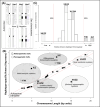This is a preprint.
Sex chromosome identification and genome curation from a single individual with SCINKD
- PMID: 40672204
- PMCID: PMC12265721
- DOI: 10.1101/2025.07.07.660342
Sex chromosome identification and genome curation from a single individual with SCINKD
Abstract
In most animal species, the sex determining pathway is typically initiated by the presence/absence of a primary genetic cue at a critical point during development. This primary genetic cue is often located on a single locus-referred to as sex chromosomes-and can be limited to females (in a ZZ/ZW system) or males (in an XX/XY system). One trademark of sex chromosomes is a restriction or cessation of recombination surrounding the sex-limited region (to prevent its inheritance in the homogametic sex). This may lead to-through a variety of mechanisms-higher amounts of genetic divergence within this region, i.e. between the X/Z and Y/W chromosomes, especially when compared to their autosomal counterparts. Recent advances in genome sequencing and computation have brought with them the ability to resolve haplotypes within a diploid individual, permitting assembly of previously challenging genomic regions like sex chromosomes. Leveraging these advances, we identified replicable diagnostic characteristics between typical autosomes and sex chromosomes (within a single genome assembly). Under this framework, we can use this information to identify putative sex chromosome linkage groups across divergent vertebrate taxa and simultaneously curate misassembled regions on autosomes. Here, we present this conceptual framework and associated tool for identifying candidate sex chromosome linkage groups from a single, diploid individual dubbed Sex Chromosome Identification by Negating Kmer Densities, or SCINKD.
Conflict of interest statement
Conflict of interest statement: None declared.
Figures










Similar articles
-
Can a Liquid Biopsy Detect Circulating Tumor DNA With Low-passage Whole-genome Sequencing in Patients With a Sarcoma? A Pilot Evaluation.Clin Orthop Relat Res. 2025 Jan 1;483(1):39-48. doi: 10.1097/CORR.0000000000003161. Epub 2024 Jun 21. Clin Orthop Relat Res. 2025. PMID: 38905450
-
Sexual Harassment and Prevention Training.2024 Mar 29. In: StatPearls [Internet]. Treasure Island (FL): StatPearls Publishing; 2025 Jan–. 2024 Mar 29. In: StatPearls [Internet]. Treasure Island (FL): StatPearls Publishing; 2025 Jan–. PMID: 36508513 Free Books & Documents.
-
Idiopathic (Genetic) Generalized Epilepsy.2024 Feb 12. In: StatPearls [Internet]. Treasure Island (FL): StatPearls Publishing; 2025 Jan–. 2024 Feb 12. In: StatPearls [Internet]. Treasure Island (FL): StatPearls Publishing; 2025 Jan–. PMID: 31536218 Free Books & Documents.
-
123I-MIBG scintigraphy and 18F-FDG-PET imaging for diagnosing neuroblastoma.Cochrane Database Syst Rev. 2015 Sep 29;2015(9):CD009263. doi: 10.1002/14651858.CD009263.pub2. Cochrane Database Syst Rev. 2015. PMID: 26417712 Free PMC article.
-
Falls prevention interventions for community-dwelling older adults: systematic review and meta-analysis of benefits, harms, and patient values and preferences.Syst Rev. 2024 Nov 26;13(1):289. doi: 10.1186/s13643-024-02681-3. Syst Rev. 2024. PMID: 39593159 Free PMC article.
References
-
- Antipov D., Rautiainen M., Nurk S., Walenz B. P., Solar S. J., Phillippy A. M., & Koren S. (2024). Verkko2: Integrating proximity ligation data with long-read De Bruijn graphs for efficient telomere-to-telomere genome assembly, phasing, and scaffolding. In bioRxiv. 10.1101/2024.12.20.629807 - DOI - PMC - PubMed
-
- Bergero R., & Charlesworth D. (2009). The evolution of restricted recombination in sex chromosomes. Trends in Ecology & Evolution, 24(2), 94–102. - PubMed
Publication types
Associated data
Grants and funding
LinkOut - more resources
Full Text Sources
